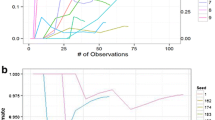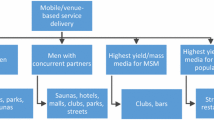Abstract
Obtaining samples of populations at risk for HIV challenges surveillance, prevention planning, and evaluation. Methods used include snowball sampling, time location sampling (TLS), and respondent-driven sampling (RDS). Few studies have made side-by-side comparisons to assess their relative advantages. We compared snowball, TLS, and RDS surveys of men who have sex with men (MSM) in Forteleza, Brazil, with a focus on the socio-economic status (SES) and risk behaviors of the samples to each other, to known AIDS cases and to the general population. RDS produced a sample with wider inclusion of lower SES than snowball sampling or TLS—a finding of health significance given the majority of AIDS cases reported among MSM in the state were low SES. RDS also achieved the sample size faster and at lower cost. For reasons of inclusion and cost-efficiency, RDS is the sampling methodology of choice for HIV surveillance of MSM in Fortaleza.
Similar content being viewed by others
References
ABEP (2005). Critério Econômico Brasil. http://www.gerp.com.br/Criterio.htm. Accessed 29 July 2007.
Biernacki, P., & Waldorf, D. (1981). Snowball sampling: Problems and techniques of chain referral sampling. Sociological Methods Research, 10, 141–163.
DATASUS (2006). http://www.aids.gov.br/cgi/tabcgi.exe/tabnet/ce.htm. Accessed 30 July 2006.
Erickson, B. (1979). Some problems of inference from chain data. Sociological Methodology Research, 10, 276–302.
FHI (2000). Behavioral Surveillance Survey (BSS): guidelines for repeated behavioral surveys in population at risk of HIV. Family Health International. http://www.fhi.org/en/HIVAIDS/pub/guide/bssguidelines.htm. Accessed 29 July 2007.
Heckathorn, D. D. (1997). Respondent-driven sampling: A new approach to the study of hidden populations. Social Problems, 44, 174–199.
Johnston, L. G., Khanam, R., Reza, M., Khan, S. I., Banu, S., Alam, M. S., Rahman, M., & Aziz, T. (2007). The effectiveness of respondent driven sampling for recruiting males who have sex with males in Dhaka, Bangladesh. AIDS and Behavior, August [epub ahead of publication].
Kerr-Pontes, L. R., Gondim, R., Mota, R. S., Martins, T. A., & Wypij, D. (1999). Self-reported sexual behaviour and HIV risk taking among men who have sex with men in Fortaleza, Brazil. AIDS, 13, 709–717.
Magnani, R., Sabin, K., Saidel, T., & Heckathorn, D. (2005). Review of sampling hard-to-reach and hidden populations for HIV surveillance. AIDS, 19(Suppl 2), S67–S72.
Muhib, F. B., Lin, L. S., Stueve, A., Miller, R. L., Ford, W. L., Johnson, W. D., & Smith, P. J. (2001). A venue-based method for sampling hard-to-reach populations. Public Health Reports, 116(Suppl 1), 216–222.
Ramirez-Valles, J., Heckathorn, D. D., Vazquez, R., Diaz, R. M., & Campbell, R. T. (2005). From networks to populations: The development and application of respondent-driven sampling among IDUs and Latino gay men. AIDS and Behavior, 9, 387–402.
Salganik, M. J. (2006). Variance estimation, design effects, and sample eize calculations for respondent-driven sampling. Journal of Urban Health, 83, 98–112.
Salganik, M. J., & Heckathorn, D. D. (2004). Sampling and estimation in hidden populations using respondent-driven sampling. Sociological Methods Research, 34, 193–239.
Stueve, A., O’Donnell, L. N., Duran, R., San, D. A., & Blome, J. (2001). Time-space sampling in minority communities: Results with young Latino men who have sex with men. American Journal of Public Health, 91, 922–926.
Acknowledgments
We wish to acknowledge the support of the University of California, San Francisco, Center for AIDS Prevention Studies, U.S. National Institute of Mental Health (NIMH), P30 MH062246; AIDS International Training in Research Program (AITRP), Fogarty International Center, D43TW00003; and the International Traineeships in AIDS Prevention Studies, U.S. NIMH, R25MH064712. This work was supported by the National AIDS Prevention Program of the Brazilian Ministry of Health and the Centers for Disease Control-Global AIDS Program through the University Technical Assistance Project, Tulane University (U62/CCU622410-01).
Author information
Authors and Affiliations
Corresponding author
Additional information
This work does not represent the opinions of the Ministry of Health of Brazil, CDC, or US DHHS, only those of the authors.
Rights and permissions
About this article
Cite this article
Kendall, C., Kerr, L.R.F.S., Gondim, R.C. et al. An Empirical Comparison of Respondent-driven Sampling, Time Location Sampling, and Snowball Sampling for Behavioral Surveillance in Men Who Have Sex with Men, Fortaleza, Brazil. AIDS Behav 12 (Suppl 1), 97–104 (2008). https://doi.org/10.1007/s10461-008-9390-4
Received:
Accepted:
Published:
Issue Date:
DOI: https://doi.org/10.1007/s10461-008-9390-4




